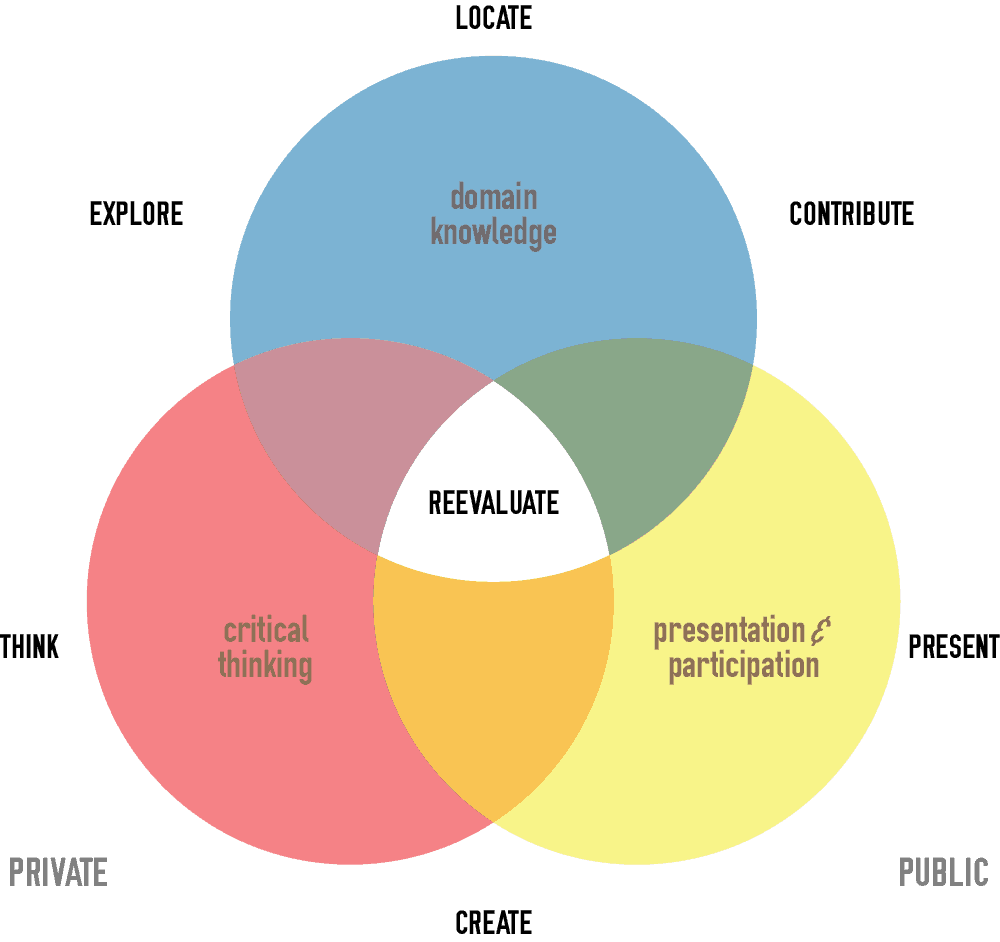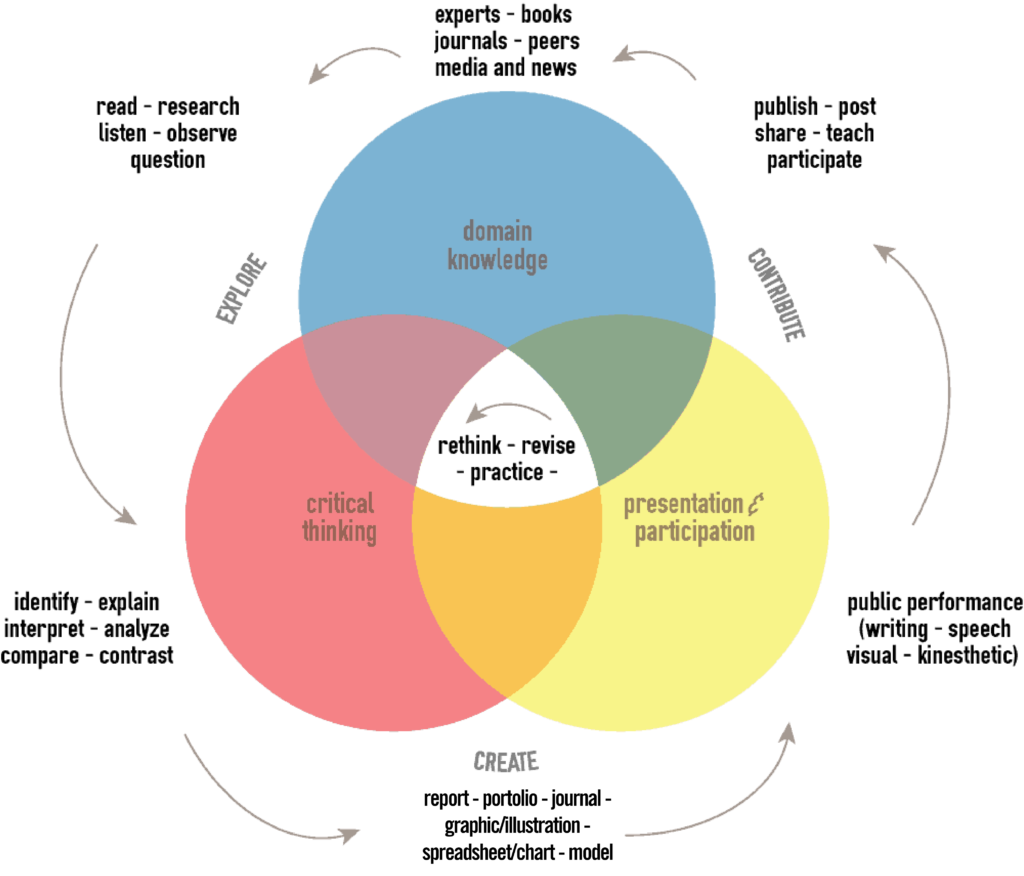The Learning Assessment Cycle
Information Fluency in action.
What is It?
The Learning Assessment Cycle (LAC) is a process for organizing student assignments and activities, where the main goal is to lead students through each of the three spheres of the Information Fluency Triad and then (this is the important part) allow them to revise their understanding of concepts or revise their skill sets based on your assessment and feedback.
In curriculum design, the Learning Assessment Cycle can act as a map for organizing a course’s structure so that students complete a cycle at least once in a course.
How Can I Use the Learning Assessment Cycle in My Course?
Here are some semi-concrete examples of activities students could do to engage fully in the cycle:
- Locating domain knowledge
- Exploring and evaluating the domain knowledge; researching related ideas
- Thinking critically about the existing body of knowledge and any newly gathered data
- Creating a product to demonstrate original thought on the subject
- Presenting a first draft of the product and receiving constructive feedback
- Re-evaluating and revising based on the feedback
- Presenting a refined version
- Ultimately contributing something new to domain knowledge
In the expanded diagram to the right, we’ve fleshed out additional cues for guiding students through the process.


Questions and Considerations
If you’re teaching an online course, making sure that students have an engaged way to progress through the Learning Assessment Cycle can be challenging. Here are some things you should be thinking about for your online courses.
- Remember that not all assignments need to have the entire cycle built into it. Think about building the cycle into your entire course as a whole instead.
- Technology can mediate any part of the LAC, but if this is your first time building an online course, choose one tool for students to use.
Consider the following questions and try to uncover and modify any previously held notions that may be inherited rather than arising from your own teaching practice and experience.
What role does revision play in your discipline?
If your students engage in any revision, is your feedback part of the process?
Which part of the learning assessment cycle is most represented in your course?
Least represented?
The web has opened up innumerable opportunities for public presentation and participation; have you explored how students might use these opportunities to learn about the process of “peer review” and it’s value in the development of knowledge?
Do you give your students a chance to create something of value based on the domain knowledge in your course?
If you provide feedback for demonstrations of understanding, do your students have a chance to revise misunderstandings or misapplications?
Technologies
The following list contains a limited set of examples for online activities that allow students to work through the entire cycle:
- Locating and storing domain knowledge by creating a Google Drive folder that contains pdfs, images and videos and then sharing that folder with you for evaluation and feedback on the quality of the items that were collected.
- Thinking critically about the existing body of knowledge and any newly gathered data by generating a mind map of how various concepts are linked together, creating a taxonomic map. Additionally, students can engage in the critical thinking process in well-constructed discussion boards.
- Creating a product to demonstrate original thought on the subject through the creation of a video journal entry where the student discusses questions that are beginning to emerge for them on the subject (remember that “original to the student” may be different than “original to the whole world”).
- Receiving constructive feedback from you on any of the above tasks through a shared Google Doc that outlines places to revise and reconstruct understanding when needed.
- Re-evaluating and revising based on the feedback. Students would simply reuse the same technologies used in the first round of artifact creation.
- Presenting a refined version of the activity to a cohort of peers to share their new mastery of a domain area by posting a video abstract of a project on YouTube that is shared with the class.
- Ultimately contributing something new to domain knowledge by submitting any truly original research, ideas, or projects to online journals, websites, or online communities where their contributions would be valued.
Research Foundations
Bjork, E. L., & Bjork, R. A. (2011). Making things hard on yourself, but in a good way: Creating desirable difficulties to enhance learning. Psychology and the real world: Essays illustrating fundamental contributions to society, 56-64.
Facione, P.A. Critical Thinking: A Statement of Expert Consensus for Purposes of Educational Assessment and Instruction. Research Findings and Recommendations. American Philosophical Association.
Fluckiger, J., Vigil, Y. T. Y., Pasco, R., & Danielson, K. (2010). Formative feedback: Involving students as partners in assessment to enhance learning. College teaching, 58(4), 136-140.
Kriz, S., & Hegarty, M. (2004, January). Constructing and revising mental models of a mechanical system: The role of domain knowledge in understanding external visualizations. Proceedings of the Cognitive Science Society (Vol. 26, No. 26).
Faculty Perspectives
UAF Associate Director of Online Programs and Instructor of Online Pedagogy Owen Guthrie explains the Learning Assessment Cycle.
